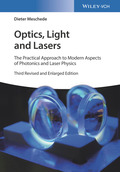Optics, Light and Lasers
The Practical Approach to Modern Aspects of Photonics and Laser Physics

3. Edition April 2017
XX, 528 Pages, Softcover
389 Pictures
27 tables
Textbook
Short Description
This text has been written for newcomers to the field. The author explains difficult effects in a straightforward and easily comprehensive way. This updated and enlarged edition features new chapters on new topics like plasmonics, femtocombs, and quantum cascade lasers.
Buy now
Price: 97,90 €
Price incl. VAT, excl. Shipping
Euro prices for Wiley-VCH and Ernst & Sohn titles are only valid for Germany. In EU countries, local VAT applies. Postage will be charged.
This new, updated and enlarged edition of the successful and exceptionally well-structured textbook features new chapters on such hot topics as optical angular momentum, microscopy beyond the resolution limit, metamaterials, femtocombs, and quantum cascade lasers. It provides comprehensive and coherent coverage of fundamental optics, laser physics, and important modern applications, while equally including some traditional aspects for the first time, such as the Collins integral or solid immersion lenses.
Written for newcomers to the topic who will benefit from the author's ability to explain difficult theories and effects in a straightforward and readily comprehensible way.
1.1 Light rays in human experience.
1.2 Ray optics.
1.3 Reflection.
1.4 Refraction.
1.5 Fermat's principle: the optical path length.
1.6 Prisms.
1.7 Light rays in wave guides.
1.8 Lenses and curved mirrors.
*1.9. Autofocus
1.10 Matrix optics.
1.11 Ray optics and particle optics.
Problems for chapter 1.
2 Wave optics.
2.1 Electromagnetic radiation fields.
2.2 Wave types.
2.3 Gaussian beams.
Add: Collins integral
*2.3. Beyond Gaussian Beams
2.4 Polarization.
2.5 Diffraction.
Problems for chapter 2.
3 Light propagation in matter.
3.1 Dielectric interfaces.
3.2 Complex refractive index.
3.3 Optical wave guides and fibres.
3.4 Functional types and applications of optical fibres.
3.6 Photonic materials.
*NEW: Nano-Optis and Plasmonics
3.7 Light pulses in dispersive materials.
3.8 Anisotropic optical materials.
3.9 Optical modulators.
Problems for chapter 3.
4 Optical images.
4.1 The human eye.
4.2 Magnifying glass and eyepiece.
4.3 Microscopes.
4.4 Telescopes.
4.5 Lenses: designs and aberrations.
*4.6. Aspherical lenses
Problems for chapter 4.
5 Coherence and interferometry.
5.1 Young's double slit.
5.2 Coherence and correlation.
5.3 The double-slit experiment.
5.4 Michelson interferometer: longitudinal coherence.
5.5 Fabry-Perot interferometer.
5.6 Optical cavities.
*update: Microresonators
5.7 Thin optical films.
5.8 Holography.
5.9 Laser speckle (laser granulation).
Problems for chapter 5.
6 Light and matter.
6.1 Classical radiation interaction.
6.2 Two-level atoms.
6.3 Stimulated and spontaneous radiation processes.
6.4 Inversion and amplification.
Problems for chapter 6.
7 The laser.
7.1 The classic system: the He-Ne laser.
7.2 Mode selection in the He-Ne laser.
7.3 Spectral properties of the He-Ne laser.
7.4 Applications of the He-Ne laser.
7.5 Other gas lasers.
7.6 Molecular gas lasers.
7.7 The workhorses: solid-state lasers.
7.8 Selected solid-state lasers.
7.9 Tunable lasers with vibronic states.
7.10 Tunable ring lasers.
Problems for chapter 7.
8 Laser dynamics.
8.1 Basic laser theory.
8.2 Laser rate equations.
8.3 Threshold-less lasers and micro-lasers.
8.4 Laser noise.
8.5 Pulsed lasers.
*8.6. Femtocombs
Problems for chapter 8.
9 Semiconductor lasers.
9.1 Semiconductors.
9.2 Optical properties of semiconductors.
9.3 The heterostructure laser.
9.4 Dynamic properties of semiconductor lasers.
9.5 Laser diodes, diode lasers, laser systems.
9.6 High-power laser diodes.
*9.7 Quantum Cascade lasers + update
Problems for chapter 9.
10 Sensors for light.
10.1 Characteristics of optical detectors.
10.2 Fluctuating opto-electronic quantities.
10.3 Photon noise and detectivity limits.
10.4 Thermal detectors.
10.5 Quantum sensors I: photomultiplier tubes.
10.6 Quantum sensors II: semiconductor sensors.
10.7 Position and image sensors.
10.8. Superconducting detectors
Problems for chapter 10.
11 Laser spectroscopy.
11.1 Laser-induced fluorescence (LIF).
11.2 Absorption and dispersion.
11.3 The width of spectral lines.
11.4 Doppler-free spectroscopy.
11.5 Transient phenomena.
11.6 Light forces.
11.7. Remote Sensing, Trace gases, etc.
Problems for chapter 11.
12 Photons - an introduction to quantum optics.
12.1 Does light exhibit quantum character?
12.2 Quantization of the electromagnetic field.
12.3 Spontaneous emission.
12.4 Weak coupling and strong coupling.
12.5 Resonance fluorescence.
12.6 Light fields in quantum optics.
12.7 Two-photon optics.
12.8 Entangled photons.
*12.9 Quantum Communication
Problems for chapter 12.
13 Nonlinear optics I: optical mixing processes.
13.1 Charged anharmonic oscillators.
13.2 Second-order nonlinear susceptibility.
13.3 Wave propagation in nonlinear media.
13.4 Frequency doubling.
13.5 Sum and difference frequency.
13.6 Optical parametric oscillators.
Problems for chapter 13.
14 Nonlinear optics II: four-wave mixing.
14.1 Frequency tripling in gases.
14.2 Nonlinear refraction coefficient (optical Kerr effect).
*14.2 add: Z-Scan Method
14.3 Self-phase modulation.
Problems for chapter 14.
Appendix.
A Mathematics for optics.
A.1 Spectral analysis of fluctuating measurable quantities.
A.2 Poynting theorem.
B Supplements in quantum mechanics.
B.1 Temporal evolution of a two-state system.
B.2 Density-matrix formalism.
B.3 Density of states.
Bibliography.
Index.


